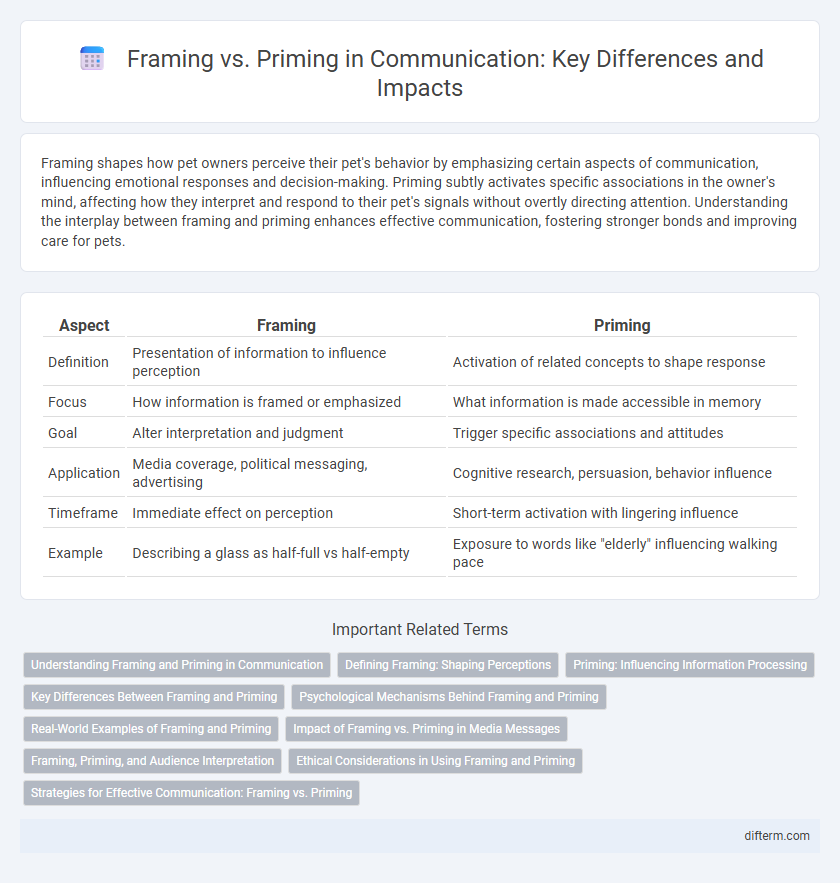Framing shapes how pet owners perceive their pet's behavior by emphasizing certain aspects of communication, influencing emotional responses and decision-making. Priming subtly activates specific associations in the owner's mind, affecting how they interpret and respond to their pet's signals without overtly directing attention. Understanding the interplay between framing and priming enhances effective communication, fostering stronger bonds and improving care for pets.
Table of Comparison
| Aspect | Framing | Priming |
|---|---|---|
| Definition | Presentation of information to influence perception | Activation of related concepts to shape response |
| Focus | How information is framed or emphasized | What information is made accessible in memory |
| Goal | Alter interpretation and judgment | Trigger specific associations and attitudes |
| Application | Media coverage, political messaging, advertising | Cognitive research, persuasion, behavior influence |
| Timeframe | Immediate effect on perception | Short-term activation with lingering influence |
| Example | Describing a glass as half-full vs half-empty | Exposure to words like "elderly" influencing walking pace |
Understanding Framing and Priming in Communication
Framing in communication shapes how information is presented, influencing audience interpretation by highlighting specific aspects or angles of a message. Priming activates related concepts in the audience's memory, affecting how they respond to subsequent information based on prior exposure. Both framing and priming play crucial roles in guiding perception and decision-making by subtly shaping cognitive associations and emotional reactions.
Defining Framing: Shaping Perceptions
Framing in communication involves strategically shaping perceptions by emphasizing specific aspects of a message to influence audience interpretation and response. This technique directs attention to particular elements, guiding how information is understood without altering the factual content. By selecting certain frames, communicators can highlight values, causes, or consequences, effectively shaping public attitudes and decision-making processes.
Priming: Influencing Information Processing
Priming influences information processing by activating specific associations in memory, which shapes how individuals interpret subsequent information. This cognitive mechanism causes certain thoughts or feelings to become more accessible, thereby guiding attention and decision-making without conscious awareness. Effective priming adjusts perceptions and responses by subtly preparing the audience to process messages in a predetermined way.
Key Differences Between Framing and Priming
Framing influences how information is presented to shape audience interpretation by emphasizing certain aspects or perspectives. Priming activates specific associations in memory, affecting subsequent responses or judgments unconsciously. The key difference lies in framing altering the narrative structure, while priming modifies cognitive accessibility without overtly changing the message itself.
Psychological Mechanisms Behind Framing and Priming
Framing influences communication by shaping how information is presented, affecting perception through selective emphasis and context construction. Priming operates through subconscious activation of specific associations in memory, altering responses without overt awareness. Both mechanisms engage cognitive processes that modify interpretation and decision-making based on experiential cues and contextual framing.
Real-World Examples of Framing and Priming
Framing shapes public perception by highlighting specific aspects of a message, as seen in media coverage where crime is framed as a law enforcement failure, influencing public opinion on policies. Priming activates certain associations, such as political campaigns using repeated slogans to increase voter focus on particular issues like economic stability. Both framing and priming demonstrate their power through real-world examples in advertising, news reporting, and political communication, significantly affecting attitudes and decisions.
Impact of Framing vs. Priming in Media Messages
Framing shapes audience perception by emphasizing certain aspects of a message, influencing how information is interpreted and prioritized. Priming activates related thoughts and associations in memory, affecting subsequent judgments and decisions based on media exposure. Together, framing and priming significantly impact public opinion, guiding attitudes through selective emphasis and mental accessibility.
Framing, Priming, and Audience Interpretation
Framing shapes audience interpretation by highlighting specific aspects of information, influencing how individuals perceive and evaluate messages. Priming activates related concepts in the audience's mind, subtly guiding their responses based on recent exposure to particular stimuli. Both framing and priming leverage cognitive processes to affect judgment, but framing directly constructs the meaning context, while priming alters accessibility of related ideas.
Ethical Considerations in Using Framing and Priming
Ethical considerations in using framing and priming revolve around transparency, manipulation avoidance, and respect for audience autonomy. Framing can shape perceptions by highlighting specific aspects, while priming activates certain associations, both requiring careful use to prevent misleading or exploiting audiences. Upholding ethical standards ensures communication fosters informed decision-making without compromising trust or individual agency.
Strategies for Effective Communication: Framing vs. Priming
Framing shapes audience perception by emphasizing specific aspects of a message, influencing how information is interpreted through contextual cues and word choice. Priming prepares the audience's mindset by activating related concepts or emotions before delivering the core message, enhancing receptivity and recall. Effective communication strategies leverage framing to guide interpretation while using priming to create a favorable cognitive environment, maximizing message impact.
framing vs priming Infographic

 difterm.com
difterm.com